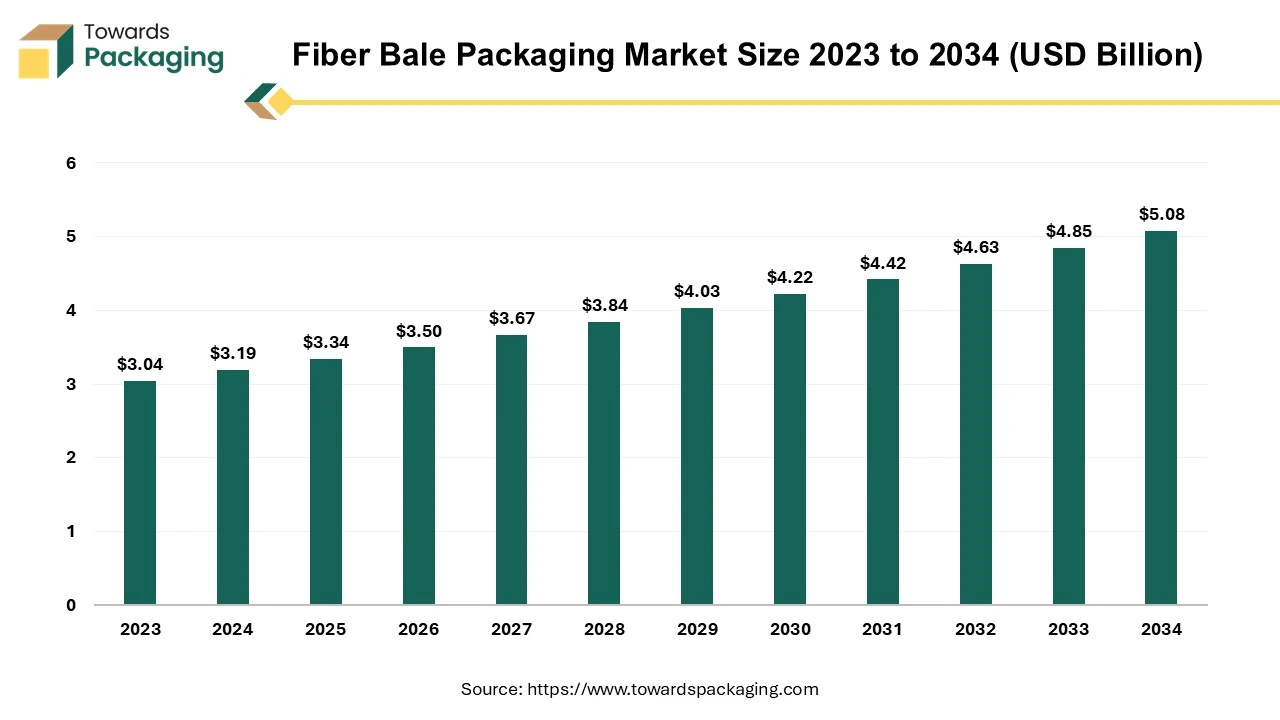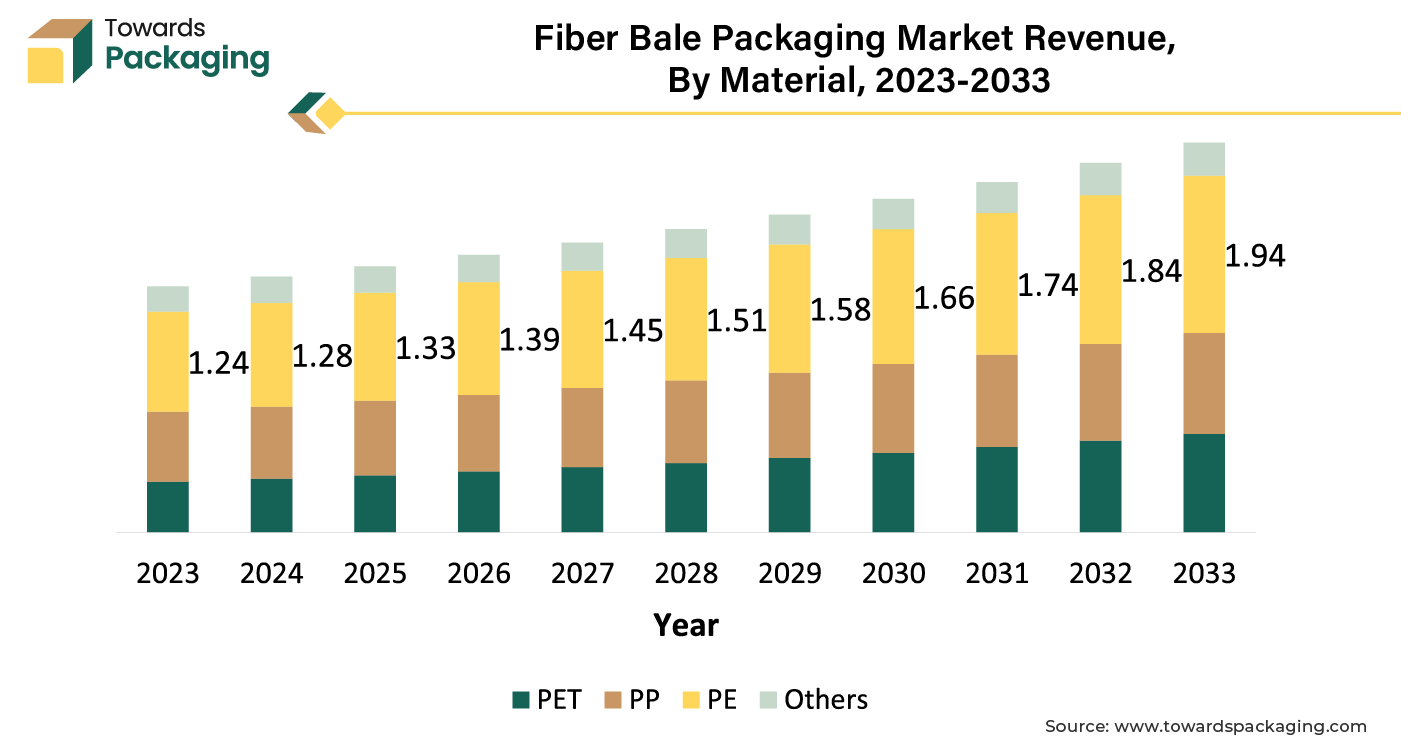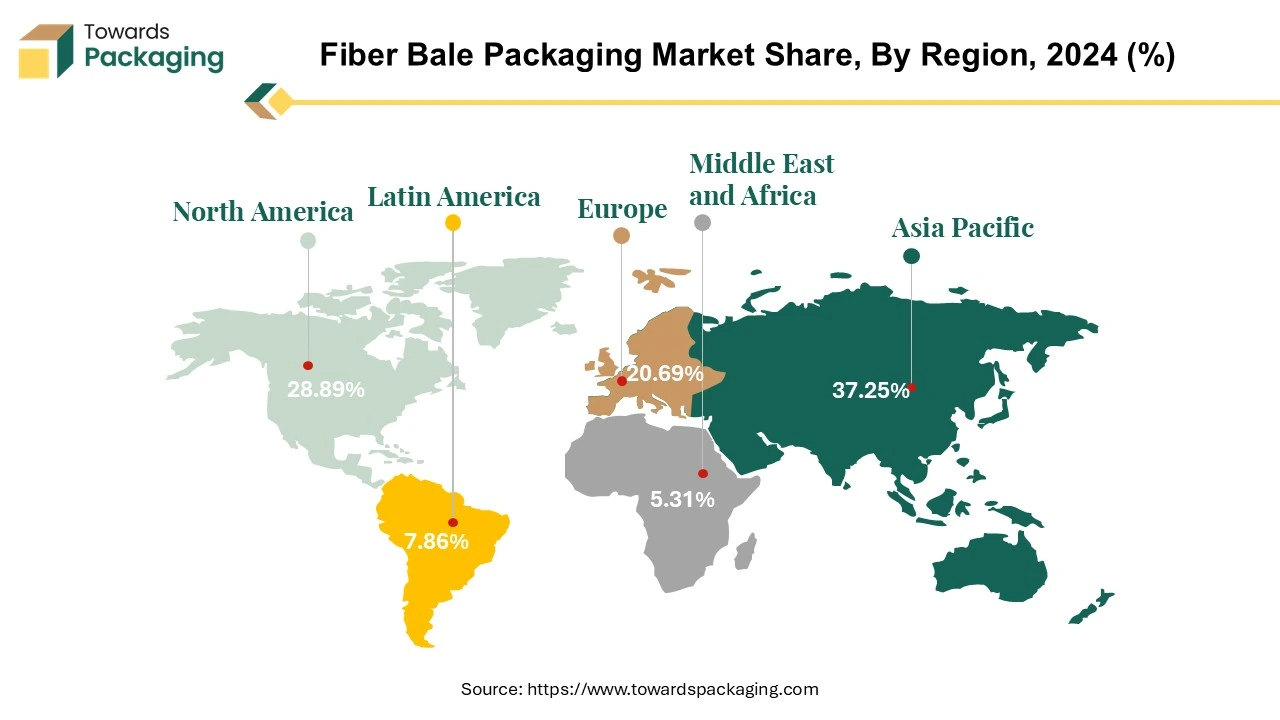April 2025
The fiber bale packaging market is set to grow from USD 3.34 billion in 2025 to USD 5.08 billion by 2034, with an expected CAGR of 4.79% over the forecast period from 2025 to 2034.

Unlock Infinite Advantages: Subscribe to Annual Membership
The fiber bale packaging market is likely to witness strong growth over the forecast period. Fiber bale packing requires shrinking items into huge, compact bundles that are then securely wrapped and tied with materials like wires or cables. Although this type of packaging is especially useful for bulk goods handled by a variety of industries, it is especially common for commodities such as cotton, hay and clothing materials. Due to its many advantages, this packaging is a top pick for companies looking to improve their shipping handling operations.
The increasing global demand for textiles and the population growth along with the rising disposable incomes are expected to augment the growth of the Fiber bale packaging market during the forecast period. Furthermore, the growing sustainability concerns are pushing industries toward eco-friendly packaging options which are further driving its adoption globally. Additionally, the regulatory pressures in both the developed and developing regions as well as the expansion of e-commerce and the rise in the global recycling activities, mainly for textiles is also projected to contribute to the growth of the market in the years to come. The packaging industry size is growing at a 3.16% CAGR.
The increasing textile production is projected to support the growth of the fiber bale packaging market during the forecast period. This is owing to the population growth, increase in disposable incomes and changing fashion trends. As per the data by the US Census Bureau, the Manufacturers' Shipments, Inventories, and Orders (M3) survey and the Annual Survey of Manufactures (ASM), the expected value of shipments of U.S. clothes, textiles, and man-made fiber in 2022 was $65.8 billion, up from $64.04 billion in 2021. Correspondingly, according to the U.S. Department of Commerce and U.S. International Trade Commission, In comparison to 2021, US exports increased as well. Fiber, textile and clothing exports totalled $34 billion in 2022 as compared to $28.4 billion in 2021. As per the figures by the US Census Bureau and the Annual Capital Expenditures Survey (ACES), compared to $1.85 billion in 2020, investments in the production of fabric, yarn, clothing and sewn products reached $2.27 billion in 2021.
This increase in the production volumes is likely to increase the demand for efficient fiber bale packaging systems for managing the larger quantities of the raw materials. Furthermore, the need for effective and dependable packaging options to handle the massive volumes of raw fibers such as the cotton, wool and synthetic materials, is rising as economies like China and India keep expanding their textile manufacturing capacities. Due to their substantial manufacturing as well as exporting contributions to the global textile industry, these countries are also driving the demand for the premium packaging that guarantees the secure storage and transit of fibers from suppliers or farms to the manufacturing facilities.
The availability of the various substitute packaging is projected to hinder the growth of the fiber bale packaging market during the forecast period. One of the most significant trends impacting this market is the rising popularity of reusable and returnable packaging systems. Reuse packaging is defined as packaging that is intended to be used more than once. These kinds of packaging are long-lasting, simple to use and easy to keep clean.
These include transport and industrial packaging as well as consumer packaging like containers for beverages and zip-lock bags. By lowering the demand for production, it aids in further reducing the carbon impact. Reducing the frequency of single-use package manufacturing allows businesses to save labor, energy and raw material costs. There are applications of reusable packaging in both residential and commercial sectors. It is frequently employed in the commercial sector for shipping raw materials to the processing unit and to move subcomponents to the assembly location.
Furthermore, the emergence of biodegradable and compostable packaging also acts as is a better alternative. An increasingly popular substitute is the biodegradable packaging, as both the consumers as well as the companies seek out methods that minimize their environmental effect. Packaging that minimizes pollution, decomposes into natural materials and fills landfills with less waste is an attractive concept. Also, compostable packaging is another substitute that, given the proper conditions, will decompose organically. It doesn't leave any hazardous chemicals or dangerous particles behind since it is made up of the organic materials like paper, cardboard or bioplastics. Thus, due to the presence of these popular alternative materials, the demand for the fiber bale packaging is likely to reduce during the forecast period.
The rapid growth of the e-commerce is expected to create immense growth opportunities for the fiber bale packaging market in the years to come. There has been a substantial rise in the e-commerce in recent times, following the Covid-19 outbreak. Future generations have an automatic attraction towards the online shopping, particularly the Gen Z and Millennials. Not only is online purchasing convenient, but it is frequently favored as well. The expansion and acceptance of the internet trading is further accelerated by this shift in the customer behavior. Additionally, e-commerce is growing rapidly every day due to the technological advancements, especially in the area of the virtual reality (VR). Furthermore, the significant expansion of various e-commerce platforms and recent launches of online stores by retailers into is also expected to contribute to the growth of the market. For instance
Thus, with the continuous expansion of the online retail, the demand for fiber bale packaging is also likely to increase to guarantee safety of the products during the direct-to-consumer shipping.

The PE segment captured largest market share of 40.65% in 2024. Polyethylene (PE), especially the high-density form (HDPE), is valued for its remarkable strength, durability and moisture resistance, which makes it a great option for heavy-duty packaging applications. The material's flexibility permits it to be used in a variety of applications, from lightweight agricultural products to more robust industrial and construction materials. PE's affordability and ease of processing further contribute to its widespread adoption, particularly in price-sensitive markets like agriculture and textiles. The growing demand for recyclable and sustainable packaging solutions has further increased the popularity of PE.
The textiles segment held considerable market share in 2024. This is owing to the growing consumer base which has resulted in increase in the consumption of apparel, home textiles and industrial fabrics. Furthermore, the global expansion of the apparel and fashion industries coupled with the growing e-commerce sector is also likely to support the segmental growth of the market. Additionally, availability of large quantity of raw material as well as skilled manpower along with the growing trend in the utilization of the smart textiles is also expected to contribute to the growth of the segment during the forecast period.

Asia Pacific held is likely to grow at fastest CAGR of 6.58% during the forecast period. This is owing to the ongoing industrialization and urbanization across major economies like China, India and Southeast Asian economies. Additionally, the expanding textile industry is also anticipated to promote the growth of the market in the region in the years to come.
According to the data by the India Brand Equity Foundation, by 2030, the market for clothing and textiles in India is expected to expand at a CAGR of 10% and reach US$ 350 billion. Also, India ranks third globally in terms of textile and apparel exports. India is anticipated to surpass US$100 billion in exports, placing it amongst the top five worldwide exporters in several of textile categories. Furthermore, the high production of cotton, jute and other natural fibers across the region are also expected to support the growth of the market within the estimated timeframe.
North America held considerable market share of 28.89% in 2024. This is due to the presence of leading producers of agricultural commodities including cotton along with the rise of e-commerce across the region. More than 27 million Canadians were using e-commerce in 2022, making up 75% of the country's total population, according to the International Trade Administration. By 2025, this percentage is projected to increase to 77.6%. Retail e-commerce revenues across Canada have surged as a result of an increase in online shoppers. As per the Statistics Canada, e-commerce sales were estimated to be around US$2.34 billion in March 2022. By 2025, online retail sales are projected to reach a total of US$40.3 billion. Also, the well-developed supply chain and logistics infrastructure is further expected to support regional growth of the market in the years to come.
By Material
By Bale Weight
By End-Use
By Region
April 2025
April 2025
April 2025
April 2025